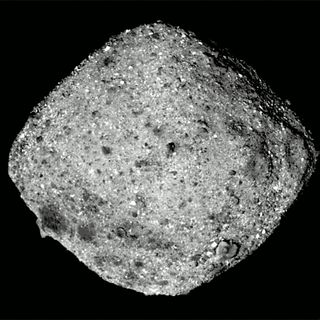What's Next for NASA's OSIRIS-REx Probe at Asteroid Bennu?
NASA's first asteroid-sampling mission has arrived at its destination, but it still has a lot of prep work ahead before the spacecraft can bite into the space rock.
Yesterday (Dec. 3), NASA's OSIRIS-REx probe sidled up to its diamond-shaped target, the near-Earth asteroid Bennu, ending a deep-space chase that lasted 27 months and covered more than 1.25 billion miles (2 billion kilometers).
The main goal of the $800 million OSIRIS-REx mission involves snagging a sizeable sample of asteroid material and returning it to Earth in 2023. But the spacecraft is far from ready to collect any space-rock rubble. Indeed, OSIRIS-REx isn't even in orbit around the 1,650-foot-wide (500 meters) Bennu yet; it's currently flying alongside the asteroid, just beginning to take its measure in detail. [OSIRIS-REx: NASA's Asteroid Sample-Return Mission in Pictures]
OSIRIS-REx will continue doing this over the next four weeks, during close flybys over Bennu's north pole, equator and south pole that will bring the probe as close as 4.4 miles (7.1 kilometers) to the asteroid's surface.

Mission team members want to make sure they nail down Bennu's mass and precise shape before slipping into orbit around the asteroid on Dec. 31. And there's a very good reason for that.
Although Bennu has been characterized well by ground-based instruments over the years, "maneuvering around a small body that basically has no gravity is a very challenging endeavor," OSIRIS-REx Deputy Principal Investigator Heather Enos, of the University of Arizona, told Space.com. "So, we do have to get a little more information to proceed every step of the way."
To give you an idea of just how delicate the New Year's Eve operation will be: OSIRIS-REx will be moving just 4 inches (10 centimeters) per second relative to the asteroid Bennu when it achieves orbit around the rock, mission team members have said.
Get the Space.com Newsletter
Breaking space news, the latest updates on rocket launches, skywatching events and more!
OSIRIS-REx will set a record for the closest distance that a spacecraft has ever orbited a small body, Enos added. The probe will get within just 1 mile (1.6 km) of Bennu's surface on Dec. 31, she said.
The pace won't speed up after orbital insertion. OSIRIS-REx will spend another 18 months rigorously scouting for the best place to snag its sample. The mission team expects to narrow the possibilities to two sites by July 2020, which is when the sample collection is scheduled to take place.
On the appointed day, OSIRIS-REx will spiral down and tap Bennu with its Touch-And-Go-Sample Acquisition Mechanism (TAGSAM), sucking up at least 2 ounces (60 grams) of material. The maneuver will be more of a kiss than a landing, lasting just 5 seconds or so.
OSIRIS-REx — whose name stands for "Origins, Spectral Interpretation, Resource Identification, Security-Regolith Explorer" — won't leave Bennu until March 2021, when the probe will head back toward its home planet. The asteroid sample will touch down in Utah, tucked inside a special return capsule, in September 2023.
Researchers in labs around the world will then pore over the space stuff with a variety of high-tech gear — big and expensive equipment that could never have fit aboard OSIRIS-REx (which does sport five science instruments of its own). Such analyses will address the chief mission goal: helping researchers better understand the solar system's early days, and the role that carbon-rich asteroids such as Bennu may have played in life's emergence on Earth.
The data collected by OSIRIS-REx will prove useful in a variety of other ways as well, mission team members have said. For example, the probe's measurements, and those of researchers studying the returned sample, should reveal a great deal about the resource potential of Bennu-like asteroids.
And OSIRIS-REx's precise tracking of Bennu through space will help researchers better understand the non-gravitational forces (specifically, the Yarkovsky effect) that shape asteroids' trajectories. Such work could improve asteroid-impact forecasts, NASA officials have said.
"The best times are ahead of us, so stay tuned," OSIRIS-REx Principal Investigator Dante Lauretta, also of the University of Arizona, said in a statement. "The exploration of Bennu has just begun, and we have a lifetime of adventure ahead of us."
Mike Wall's book about the search for alien life, "Out There" (Grand Central Publishing, 2018; illustrated by Karl Tate) is out now. Follow him on Twitter @michaeldwall. Follow us @Spacedotcom or Facebook. Originally published on Space.com.
Join our Space Forums to keep talking space on the latest missions, night sky and more! And if you have a news tip, correction or comment, let us know at: community@space.com.

Michael Wall is a Senior Space Writer with Space.com and joined the team in 2010. He primarily covers exoplanets, spaceflight and military space, but has been known to dabble in the space art beat. His book about the search for alien life, "Out There," was published on Nov. 13, 2018. Before becoming a science writer, Michael worked as a herpetologist and wildlife biologist. He has a Ph.D. in evolutionary biology from the University of Sydney, Australia, a bachelor's degree from the University of Arizona, and a graduate certificate in science writing from the University of California, Santa Cruz. To find out what his latest project is, you can follow Michael on Twitter.
